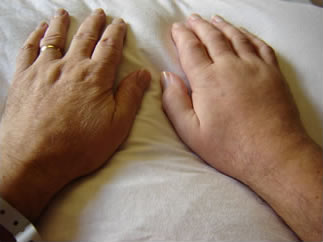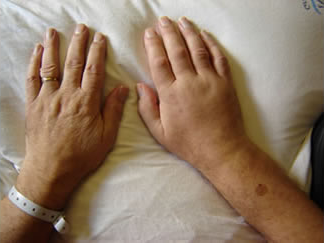Mrs McGinty’s daughter is on the ward visiting her mother. You take the opportunity to discuss Mrs McGinty’s hand swelling with her and explain why this may have happened.


It is important to remember that swelling can cause pain and hypersensitivity of limb which can limit use Mrs McGinty’s ability to self manage.
Post-stroke hand oedema is seen in approximately 1/3 of people following a stroke, but swelling has been reported in up to 2/3. It is more commonly seen as an isolated simple hand oedema or ‘wrist-hand’ swelling or in some cases as part of a more complex ‘shoulder hand syndrome’.
More information on the causes, clinical features and problems:
Cause
Loss or reduction of active movement and hence activity of the vascular muscle pump resulting in impaired venous return. This combined with poor positioning (arm allowed to ‘hang’) can cause pooling of fluid in the extremity. Studies have associated hand oedema with:
- immobility or weakness of the arm
- sensory loss
- altered tone in the fingers
- lack of attention to the affected limb
It is suggested that post-stroke hand oedema is not due to lymphodema.
Care should be taken to exclude the presence of DVT where ankle/leg swelling is present. Trauma must also be excluded.
Clinical features
- Swollen/puffy hand and wrist
- Shiny/tight skin
- Decreased skin creases/joint definition
- Stiffness in hand and wrist
Problems
- Reduced hand mobility due to swelling and consequent reduced range of movement
- Reduced functional use of the hand
- Appearance/disfigurement of the hand
- Risk of developing shoulder hand syndrome/chronic regional pain syndrome (CRPS)
- Secondary complications such as contracture due to immobility and reduced range of movement
Page last reviewed: 23 Mar 2021


